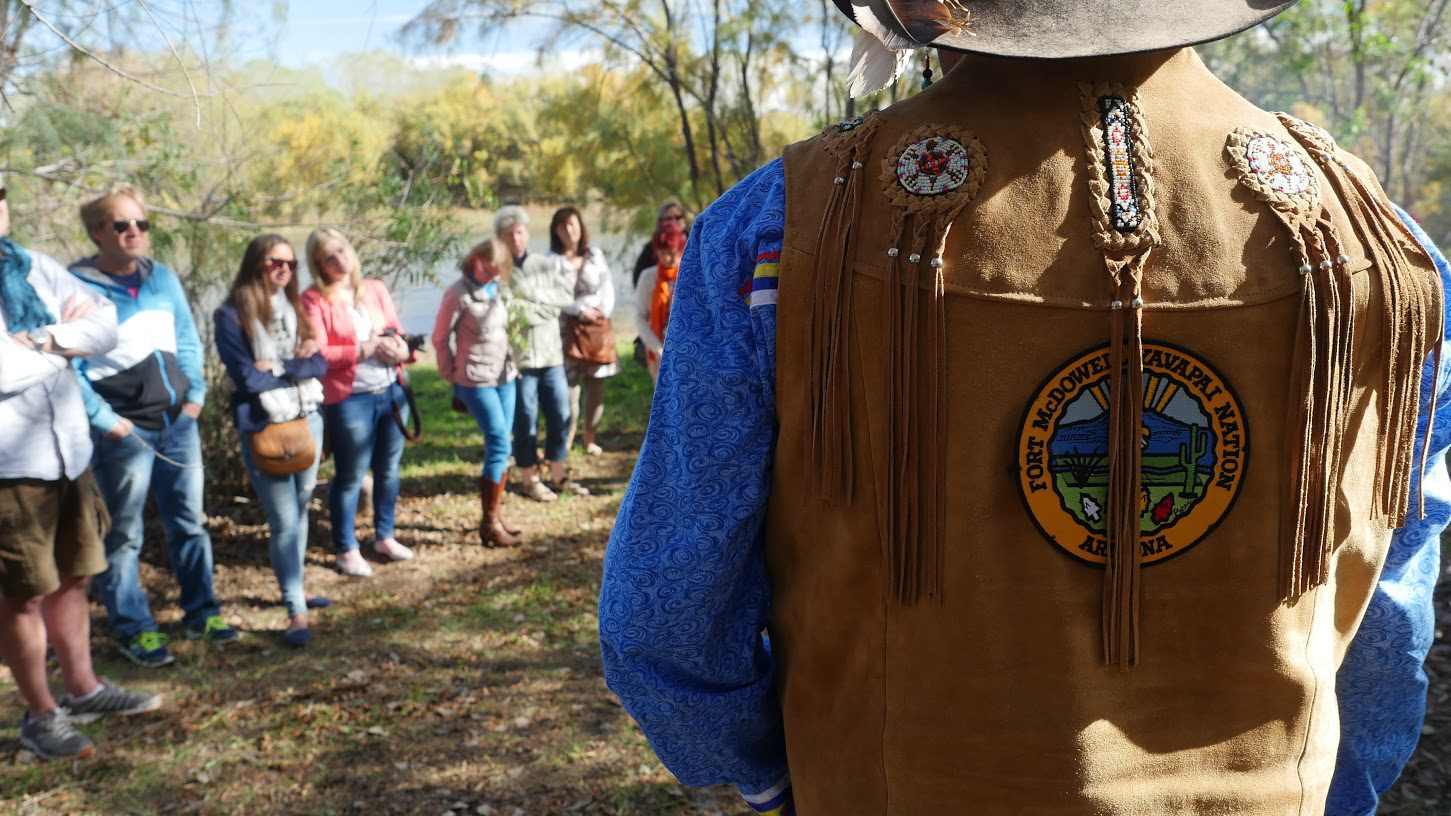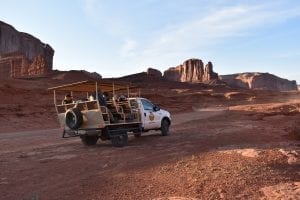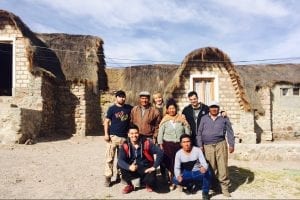Skift Take
Cultural tours to communities of color involve many parties: travel advisors, tour operators, service providers, travelers themselves, and more. So who's responsible for making sure that a trip to an indigenous community or a historically black neighborhood is carried out ethically?
Let’s say a tour group visits a Native American community, buys some jewelry, listens to a storyteller, tastes some fry bread, then leaves. Questions arise that might not apply to a generic walking tour of Chicago.
Who brought in the tourists? Who controls the storytelling? Who’s making money off this? Are the tourists patronizing Native-owned businesses and staying at Native-owned accommodations? These questions apply to indigenous communities around the world, historically black neighborhoods in cities like Paris and New York, and other spaces defined by non-white groups.
With cultural tours, the relationship between travel advisors, tour operators, service providers, travelers, and local communities is sensitive, and the culture can easily get shortchanged, both financially and in terms of controlling the narrative.
“If we are truly these experts in travel, that is what we’ve got to do,” said Gavin Tollman, CEO of tour operator Trafalgar of building ethical cultural tours.
“One of my greatest frustrations is when someone tells me it doesn’t need to be their problem because they’re only bringing a few people to X destination,” he said. “It’s everybody’s problem.”
The solution requires the mainstream industry to admit its role in perpetuating an unbalanced relationship with communities of color, then share that control with the cultures from which it profits. Communities of color also have an opportunity to develop a more robust tourism industry of their own so that community members are autonomously running and promoting their own businesses.
The Travel Advisor Industry Dodges an Ethical Quandary
The travel advisor sector appears passive at best on this topic — there is a clear lack of top-down industrywide standards for building ethical cultural tours.
“We don’t say this has to be women-owned or this has to be Native American. We just can’t,” said Karen Magee, vice president of partnerships and leisure operations at Tzell Travel Group, under the Travel Leaders Group umbrella. Tzell’s advisors are independent contractors and make their own decisions, and by the same token, Tzell assigns them no formal framework for building ethical cultural tours other than expecting them to use reliable service providers.
“I don’t get caught up in the politics,” said Jody Bear, a travel advisor and independent contractor with Tzell. Bear said she does not exercise any preference for minority guides or minority-owned hotels or businesses unless the client demands it, but emphasized that she works with knowledgeable historians and “very good guides.”
The American Society of Travel Advisors had no information about a formal framework for building ethical cultural tours, but offered a statement by email that put the onus on individual travel advisors: “Travel advisors must take into consideration some of the cultural sensitivities that come with the rise of voluntourism and take extra precautions to ensure they’re working with reputable tour operators who uphold a sense of social responsibility. Aside from partnering with responsible operators, instilling respect via education prior to a trip is another opportunity for advisors to do their part.”
Shifting the responsibility seems common. “Your best reference is not the travel advisor but the tour operators who are usually the ones to set these up,” said Jean Glock, managing director of communications and public affairs for Signature Travel Network, by email. She later followed up to say, “Recognizing and addressing any sensitivities of a local population is the top concern for all travel advisors.”
“I have not been privy to an industry standard,” said Trafalgar CEO Gavin Tollman. The tour operator created its own principles for building ethical cultural tours to include ensuring a viable economic benefit for the local community and working heavily with service providers who belong to the community.
“We all have a role to play in making sure that things are done ethically, but there is an absence of guidelines around that,” said Yves Marceau, vice president of product at tour operator G Adventures. “It would be good for the industry to put some best practices in place.”
Some Advisors and Operators Make Their Own Best Practices
Some travel advisors and their clientele make it their business to pursue ethical cultural tours. “Much of that is motivated by the traveler. None of this is mandatory,” said ASTA member and Detroit-based luxury travel advisor Kareem George. He said about 90 percent of his clientele proactively ask him about contributing to the local community.
George added that groups like ASTA have an opportunity to establish some preferred suppliers in a way that encourages ethical cultural tours. “I certainly would look to ASTA and respect if they made a statement saying: Here are partners that we want to highlight because of community engagement.”
G Adventures published an extensive set of best practices for working with indigenous communities, created in conjunction with the George Washington University. Anyone can reference this guide, which was specifically created to address a lack of industrywide guidelines. The best practices include using indigenous suppliers, ensuring fair prices and cash flow to the community, meeting or exceeding market rates, getting full consent from the community, having a plan for conflict resolution, being transparent about scaling up, avoiding anti-competitive practices, community approval of marketing materials, and allowing the community to speak for and represent itself.
“We know exactly where that money is going. After certain tours, we might go by their house,” said Kent Johnson, co-founder of tour operator Black & Abroad, about heavily prioritizing black-owned businesses when putting together an itinerary. These have included a jazz tour in Paris and a tour through that city’s Little Africa led by a woman from Cameroon who openly discussed the threat of gentrification.
“Black businesses are the most disadvantaged in the tourism sector,” said Eric Martin, co-founder of Black & Abroad. “A lot of these big companies have monopolized certain areas, which makes it a lot harder to reach those local authentic experiences.” Johnson added that a lot of people will stop their trip research after viewing the top Google search results, missing many smaller black-owned businesses.
Trafalgar prioritizes using the right channels to make respectful connections with indigenous communities, said CEO Gavin Tollman. For a tour to Colombia, Trafalgar worked with the minister of tourism and retained a Colombian anthropologist who had relationships with local tribes, who were invited to tell their own stories. Trafalgar also offers a trip in conjunction with the Navajo Nation in the U.S. revolving around Navajo-owned accommodations, eateries, and services.
Tollman said that pursuing this ethical balance is “a lot” more work for Trafalgar, “but that’s the fun of it.”
Who Makes Money Off Trips to Communities of Color?
For travel advisors, the answer to this question varies wildly on whether they choose to partner with and thereby pay community-based service providers.
The sales opportunity here is significant. Historical and heritage tours comprised the fastest growing segment of experiences in 2017, with a 125 percent increase in global bookings and a 98 percent increase in U.S. bookings, according to a TripAdvisor report. Seventy-six percent of U.S. leisure travelers participate in cultural and heritage-related activities, comprising an overall spend of $171 billion, according to a 2013 report from Mandala Research. Karen Magee of Tzell also noted that demand for cultural tours has picked up in the last year or two, tied to travelers’ desires for niche and local experiences.
Luxury travel advisor George frequently sees a traditional, straightforward fee structure with his cultural tours: The community sets a fee for its services, the advisor gets a commission, and the client pays a gross price.
On top of paying for services, philanthropy can also funnel money into a community, though this is naturally not as reliable as business-to-business transactions. George said he took a group of Americans to Uganda this summer, where they visited a school with prior permission from the local community, then after meeting the students, the clients donated money and supplies. “Those that elect these destinations are looking to give something back,” said George of his affluent clientele. “They are not satisfied just taking.”
Travel advisor Jody Bear expressed having no preference for using service providers who belong to the culture she’s selling — for example black-owned businesses or Native-owned hotels — only for using historians she personally deems qualified.
G Adventures uses something it calls a Ripple Score to track how much of the company’s operating expenses stays within the community and how much leaks out. As of September 2018, G Adventures had calculated this score for 640 of its 800 tours and the average score it assigned itself was 93 percent. For its tours, the company often partners with non-governmental organizations that support economic development, said Yves Marceau — not a straight transaction with local service providers, but not exactly voluntourism either, as travelers don’t necessarily conduct volunteer work during the experience.
The nonprofit Tourism Cares, dedicated to increasing social impact in the industry, is free to take a strong stance on transparency. “Money should stay local, benefiting the community as a whole,” said Jessica Flores, director of volunteer programs, by email. “Prices should be set by the community, and for an advisor to make money on an experience, there should be dialog so the community is aware that it will be marked up to support the marketing of the experience.”
Who Controls the Storytelling?
Many cultures hold dear the idea that they have the right to tell their own stories, instead of having their stories whitewashed or otherwise rewritten by an outsider.
“We pride ourselves on giving our clients the most organic and authentic experience. It’s hard to sell authenticity when it’s someone who’s not of the stories they’re telling,” said Kent Johnson of Black & Abroad. “I’ve had civil rights tours run by white tour guides and they gave excellent background on it, but I could have gotten that same experience from reading a book.”
To illustrate, Johnson took a tour in Selma, Alabama, given by a woman who was 8 years old in 1965 on Bloody Sunday — she was there the day of the famed civil rights march from Selma to Montgomery that ended in violence. “That’s a deep, deep level of connection and learning from the experience.”
“As people of color, we’re masters of oral history and storytelling. We documented our history orally. We couldn’t write down certain things,” said Eric Martin of Black & Abroad. On a trip to Ghana, his group met with an elder to hear about the slave trade, and Martin was thereby confident that the storytelling wasn’t serving a white party line. “It was as raw as you can possibly get it.”
“Those are the moments that create repeat customers and loyalty to your brand,” said Johnson.
“If I do a plantation tour and it warrants a black former-plantation owner, then I work with them,” said travel advisor Bear. Plantation tours in the Deep South are notoriously whitewashed in their storytelling, focusing almost exclusively on topics like architecture rather than slavery, the Whitney Plantation outside New Orleans being a rare and acclaimed exception.
This is how decent white people who tell the truth about slavery on plantations are reviewed by white people. pic.twitter.com/xiomBzPpWl
— saira rao (@sairasameerarao) August 7, 2019
Tours are a crucial chance to say, “This is my culture. This is how I learned it from my ancestors,” said Executive Director Sherry Rupert of AIANTA, the Indian Country tourism board. But tours weren’t always approached like this. “Prior to AIANTA, tours were mostly done by non-Native-owned tour companies. If you were to see a Native person on the tour, great. But now tribes are really taking the opportunity to use their own voice to tell their story.”
“Our communities really want to be empowered and given the right tools to create something on their own and to run with it,” said Donovan Hanley, legislative staff assistant for the Navajo Nation office of the speaker.
There’s been significant improvement from larger tour operators including Trafalgar and Tauck, according to an AIANTA spokesperson. She said they are becoming more cognizant of true authenticity and working with Native people on the ground.
Communities Slowly Strengthen Their Own Tourism Infrastructure
AIANTA sees “Native people really stepping up” across the U.S. to build their companies and market them, said Sherry Rupert. The organization tracked a 59 percent increase in Native-owned hospitality businesses between 2007 and 2012 through the U.S. Census. AIANTA offers regular training programs for Native businesspeople, visibility for those businesses through its four-year-old trip-planning site NativeAmerica.travel, plus educational resources for advisors and operators, should they take the initiative to use them.
When it comes to non-Native-owned tour operators bringing tourists to Indian Country, “Some work with the tribes, some don’t,” said Rupert, the latter scenario being a missed opportunity, both for authenticity and for developing the Native tourism industry. The NATIVE Act will provide federal support for strengthening the Native tourism industry, but according to Rupert, implementation is only beginning. “We’re just starting out on that path,” she said.
“We’re still coming into our own,” said Rupert, in terms of Native services deserving a higher price tag and competing with non-Native services that have been visible to the traveling public for much longer.
The Navajo Nation, among the largest tribes in the U.S., is simultaneously closing two of its remaining coal mines, which were major sources of revenue, while turning to tourism as an alternative economic driver. “I see [tourism] moving at a quicker pace. There are so many younger professionals coming back to the Navajo Nation to help,” said Hanley of the Navajo Nation. He added that he has yet to see tangible benefits from the NATIVE Act, which will take years to fully implement.
Hotels comprise a big area for improvement. Navajo Nation as a tribe owns and operates only three hotels and a travel center, and finds it challenging to compete with the glut of existing non-Native hotels in the Las Vegas and Flagstaff areas that also cater to the Grand Canyon crowds, said Hanley. As a result, many tours to the community end up being day trips that include brief, one-hour cultural demonstrations and dinner, but not an overnight stay.
“The thing I keep hearing for the past 10 years is how can I have a unique experience on the Navajo Nation? Slow down,” said Hanley, adding that he’d like to see visitors make lengthier stays.
Rupert added that expanding the business of cultural tourism requires collaboration with the Native community. This has already worked between tribes and National Parks, for example with the Grand Canyon, and Rupert has seen increased visitation due to including the Native perspective. “You can’t grow it without us, our people.”
So many of these efforts boil down to truth-seeking. “How can travelers be better visitors in Indian Country?” asked Rupert.
“Do some research. Educate yourself,” she said.
The Daily Newsletter
Our daily coverage of the global travel industry. Written by editors and analysts from across Skift’s brands.
Have a confidential tip for Skift? Get in touch
Tags: asta, black travel movement, cultural tours, deep dives, diversity, g adventures, indigenous, trafalgar, travel advisors, travel agents
Photo credit: Fort McDowell, Yavapai Nation. The Indian Country tourism board in the U.S. is working on strengthening Native-owned businesses. AIANTA



